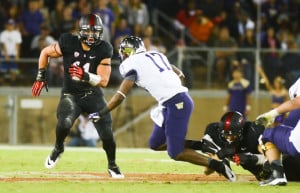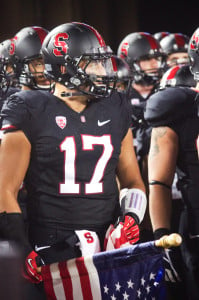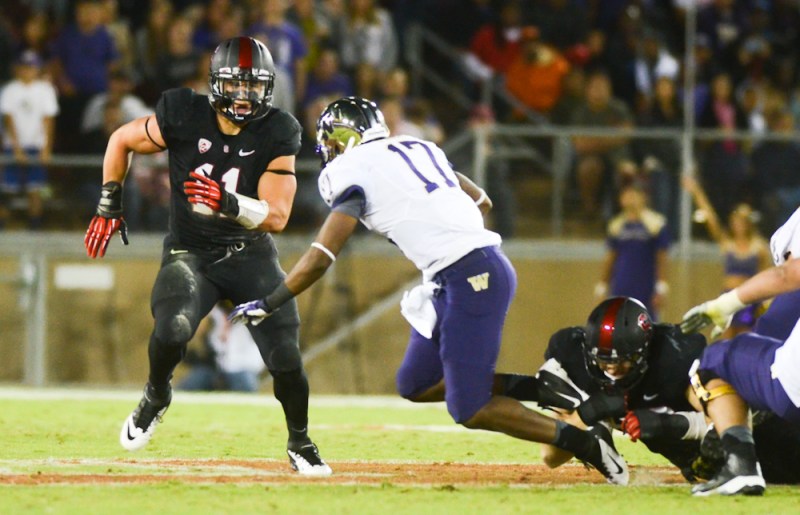There’s just something special about Stanford’s inside linebackers.
For one, a unit that consists of four seniors prides itself on special teams, of all things—and Stanford’s eye-blacked, mohawked Sports Illustrated cover boy is no exception.
“We think of ourselves as kind of like the Marines of special teams,” said fifth-year senior captain Shayne Skov. “You kind of just plug and put us in where you need us, and we can do it all.”

Nowhere is that more apparent than on the punt team, where long snapper Reed Miller is flanked by the entire inside linebacker two-deep: Joe Hemschoot and Skov on his left, A.J. Tarpley and Jarek Lancaster on his right. Even though Skov, Tarpley and Lancaster have combined for 572 tackles, 54.5 tackles for loss and 23 sacks over their careers, it’s Hemschoot, the least recognizable name of the bunch, who Skov calls the Cardinal’s most ferocious hitter.
But special teams are just the tip of the iceberg. What makes the inside linebackers truly unique is that their collective role changes dramatically every week—and that their individual roles have taken a roller-coaster ride of their own over the last two years.
To the first point, the inside linebackers have to adjust more than anyone to the bevy of different offenses that Stanford faces. One game, they’ll be clogging up the middle against a team like Army, which runs the ball over 80 percent of the time; two weeks later, they’ll have to cover speedy slot receivers like those at Washington State, whose starting pass catchers are an average 5-foot-11 in height and 184 pounds in weight; the next week, they’ll be tasked with defending Washington tight end Austin Seferian-Jenkins, a Mackey Award frontrunner who towers over the field at 6-foot-6, 276 pounds.
So how do the Cardinal’s inside linebackers fly to the ball so consistently when their assignment more or less resets every week? According to Tarpley, the first key is footwork; one bad step is all a read-option team needs to gash a defense. Even when the inside linebackers are in the right position to play either the run or the pass, they still have to fight a mental battle as well.
“A game like Washington State, you don’t want it to frustrate you,” Tarpley said, referencing the game when he and Skov combined for just eight tackles against the Cougars’ bubble screens. “Everyone is going to have a hard down.”
The unit’s speed is perhaps the biggest game-changer against the Pac-12’s spread offenses, as it gives the linebackers the ability to run down playmakers behind the line of scrimmage multiple times a game. As inside linebacker coach David Kotulski noted, though Skov and Tarpley combined for just two tackles for a loss against Washington State, both of them came on pass plays.
“It kind of shows the athletic ability that they have, going out and covering wide receivers or tackling guys,” Kotulski said. “I think both of them have an understanding of how they fit, so as different offenses present different problems, they have a great understanding of how they work together.”
That understanding extends beyond just the starters. Though sophomore Blake Martinez started the year as a second-stringer, after he suffered an injury in practice early in the season, the entire two-deep at the position has been made up of seniors.
“I think it’s interesting; just operating in an environment where any time somebody makes a mistake, they immediately know what happened,” Skov said of the group’s experience. “You’re not arguing about what it’s like on paper; you’re arguing about what the intricacies are—why you did this and why I was wrong.”
Getting to that point, however, has been anything but easy. It all started two seasons ago, when Skov, the team’s leading tackler as a sophomore in 2010, tore his ACL and MCL in the third game of the 2011 season. That thrust Lancaster and Tarpley into action.
“I think our eyes were a little wide,” Lancaster remembered. “We had some saucers for eyes, especially having to fill in for Shayne Skov, you know, giant shoes to fill, and we’d never both been in that position. So we both kind of rallied with each other.”
As Skov nursed his injury and provided guidance for his replacements, the duo pushed each other to improve, competing for playing time. Both of them shined in big moments; Tarpley recovered the game-winning fumble in triple-overtime at USC, while Lancaster went on to lead the team with 70 tackles that year.
The following offseason, Lancaster and Tarpley would be competing once again, this time to determine who would play alongside Skov for the 2012 season. Tarpley gained a slight edge in the battle because of his ability to read opposing offenses and slip by linemen, Lancaster admits, and that earned him the starting job. But Skov was impressed by both of his former replacements.
“I started essentially the first three seasons of my career, and I didn’t know if I was going to start last year,” Skov said. “That’s a testament to, within that one season, how much guys had grown and what they’d done.”
Skov did end up starting in 2012, but he wasn’t the same player who had gone off on Virginia Tech for 12 tackles and three sacks in the 2011 Orange Bowl. Though he continued to be the team’s vocal and emotional leader, his explosiveness on the field wasn’t yet back.
“We knew what he could do, you know, what he was still getting better at,” Tarpley said. “He was obviously still a great player for us. It wasn’t like he was a liability.”
After another year of healing, Skov finally is back to his 2010 form. He’s able to beat offensive playmakers to the edge again; Lancaster pinpoints that tackle for loss against Washington State, when Skov met Cougar running back Marcus Mason just after he caught a checkdown pass in the backfield.
But don’t be so quick to tab him as the No. 1 guy.
“I’m not going to sit here and take a back seat to [Skov] in any way,” Tarpley said. “And he knows that.”

To the untrained eye, Skov and Tarpley look more and more like each other every game; they share the physicality and the war-painted eye black, after all. Kotulski can still identify some differences, however.
“[Tarpley] is like that good running back that can put his foot in the ground, make somebody miss, come on back and do it again. And Shayne’s probably more of that big tailback that’s going to pound you and hit you,” Kotulksi said. “So one’s a little shiftier, but they both have toughness and athletic ability.”
“I think [Tarpley] is the smartest linebacker in our core,” Skov added. “[He] just has an all-around expansive knowledge, surpasses my knowledge of the defense probably at this point.”
Add to that Tarpley’s penchant for pass coverage—he has now picked off elite Pac-12 quarterbacks Matt Barkley, Marcus Mariota and Keith Price in consecutive seasons—and the Cardinal is set up as well as anyone in the country at inside linebacker. The replacement has become the partner in crime and all is well.
Except for one thing: Where is Lancaster?
Take a wild guess.
“Special teams is my calling here,” he said.
It might seem like a bit of a demotion for a guy who, after all, led the team in tackles just two seasons ago. But as the defensive playing time became more and more scarce over the last season and a half, Lancaster began to see things differently.
“Since redshirt freshman year, I’ve been on all four special teams,” Lancaster reflected. “It’s just a part of what kind of player I am. High-motor guy, I love to hit, I love to do whatever the team needs me to do.”
“Jarek, who did an incredible job two years ago, [is an] explosive guy,” Skov said. “I think probably the most fluid out of all of us. And I think just, also, given the situation that he’s been in, starting and not starting, [he’s] just an incredible teammate.”
“I’ve done every role that you could possibly ask me to do,” Lancaster said, “and I love it. I just like being in the locker room with the guys, and if coach says, ‘Hey, listen, if this week I need you to do this,’ well, then that’s what I’m going to do.”
Contact Joseph Beyda at jbeyda ‘at’ stanford.edu.
